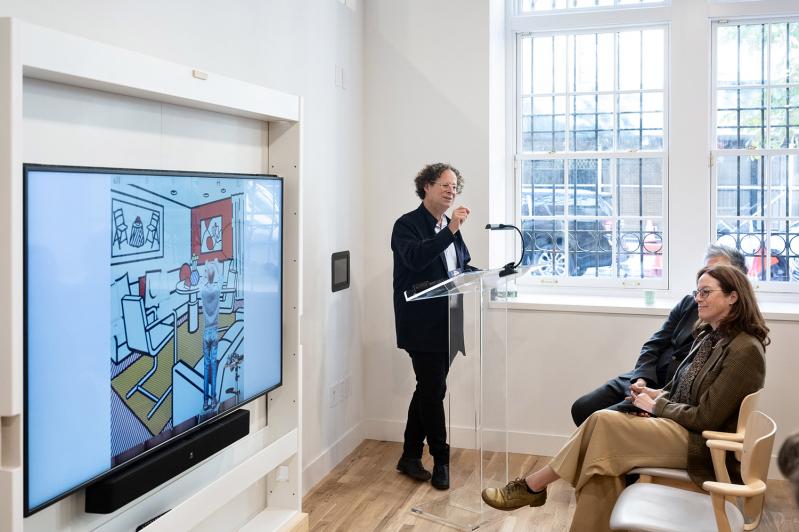On Oct. 27, Roy Lichtenstein would have been 100 years old, and family, friends, and associates were ready to celebrate.
In New York City, Mayor Eric Adams declared it Roy Lichtenstein Day, the artist's catalogue raisonné was launched online, and he was feted at a party at West Edge, above the Chelsea Market. At the same time, the Whitney Museum of American Art announced the completion of its renovation of Lichtenstein's former studio and residence on Washington Street in Greenwich Village to become the headquarters of its Independent Study Program.
At the Parrish Art Museum in Water Mill, staff members gathered at two outdoor sculptures made by the artist, who for many years had a house and studio in Southampton, to toast him.
And what would a centenary be without some commemorative stamps? The United States Postal Service has stepped into the void with five Forever stamps using representative works from his career.
The State of Ohio also got into the act with a few proclamations, an exhibition at Ohio State University, where Lichtenstein was an alumnus, and a five-person drumline from the school who played at the catalogue launch.
The product of 20 years of research and documentation, the catalogue raisonné has records for more than 5,500 recognized Lichtenstein works across multiple mediums and international collections, according to the Roy Lichtenstein Foundation. It was always the intention to make the records digital so that the catalogue could be updated and refined in reaction to new developments and data. The link is LichtensteinCatalogue.org.
"Over the past two decades dozens of expert staff members and outside researchers and consultants, here and abroad, have helped us create the catalogue raisonne that Roy Lichtenstein deserves and that the field of art history needs," Dr. Andrea Theil, who served as the director of the Roy Lichtenstein Catalogue Raisonne, said. "We all hope that the research presented in the new online catalogue raisonne will advance further studies and serve to preserve the artist's legacy."
The entries, which comprise all known paintings, sculptures, drawings, collages, prints, commissions, and other works by the artist, are in chronological order and documented with high-quality images. The catalogue includes some newly revealed works that were previously overlooked or undiscovered. Documentation includes a physical description, as well as all marks and inscriptions, and any preparatory work for the finished piece. There are also provenance records, exhibition histories, and bibliographies for each work. When available, there are studio process images and other relevant photographs.
Dr. Jack Cowart, the executive director of the foundation, who served as the senior editor of the catalogue, said the centennial was an ideal moment to "celebrate Roy, who was a thoughtful and provocative creator of lasting, monumental works. . . . A sense of stability and historic heft comes with an artist's centenary, or with the publication of a catalogue raisonné," which was one of the foundation's core missions.
Seeing as it was a birthday, the celebrations were not without gifts. The foundation has donated 180 artworks to museums and art centers as diverse as the Albertina, the Whitney, the British Museum, and the Dallas Museum of Art, which will share with Dallas's Nasher Sculpture Center 53 sculpture studies and sculptures made throughout the artist's career. In Vienna, the Albertina plans to open a new museum for large-scale modern and contemporary art that will now include 95 works of sculpture, studies, and maquettes, as well as some fiber works. The gift will serve as a European study collection along with a group of 34 works on paper previously given to the museum. The Albertina has planned a centennial exhibition for March.
Dorothy Lichtenstein, his wife, and the artist's family were responsible for the donation of the Greenwich Village building to the Whitney's Independent Study Program. On Oct. 26, Village Preservation, which works to honor and protect the architecture and cultural history of the area, unveiled a plaque on the facade at 745 Washington Street. It notes Lichtenstein's residency there from 1988 to 1997, the year of his death, the gift of the 1912 building, and the artist's career, adding, "This former ironworks foundry's ample, naturally lit spaces were ideally suited for the artist's work and, following his death, housed both the Estate and the Roy Lichtenstein Foundation offices."
The Whitney's program, in place for 55 years, has provided "instruction, space, and support" needed by artists, critics, and scholars to realize creative endeavors. The updated 11,000-square-foot building now offers studios, a classroom, study rooms, outdoor space, lounges, and dining areas.
Ms. Lichtenstein said her husband fell in love with the building and began using it as his city studio and residence in 1988. While it has been redesigned, the museum retained a few elements from its previous owner on the first floor, including a chandelier in the central stairway, ornamental details, and a rail system the artist designed to dry his paintings. Ms. Lichtenstein said she was pleased with "the sensitive way the architects designed this space, which is so important to me, and was so important to Roy. It was his favorite studio, and I know he would be very happy.”
Acknowledging the gift, Adam D. Weinberg, the museum's director, said, "The original Whitney was the studio of our founder Gertrude Vanderbilt Whitney, where she held salons and conversations and gatherings of artists. The I.S.P. is a continuation of Gertrude's tradition, and to have its first permanent home be in the same space where an iconic American artist questioned hierarchies and worked to evaluate, understand, and critique pop culture, is just perfect."




